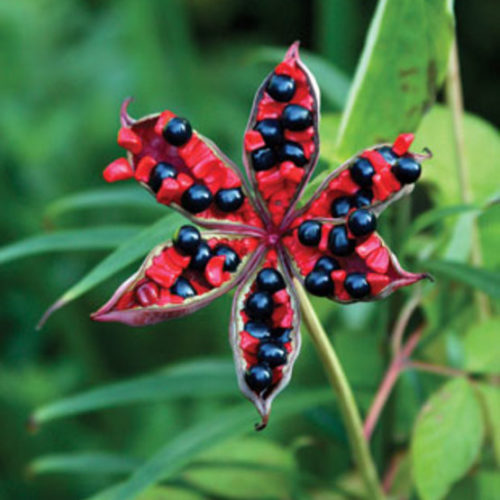
We’ve been cheerleaders for wild species peonies for years. Although they may not have the big flowers of peony hybrids, like ‘Sarah Bernhardt’, they are in a classy category all their own. Among our favorites is Japanese forest peony, not because of its blooms but because of its stunning fall seedpods. In late summer or early fall, the pods begin to split, revealing gleaming, blue-black pearls nestled among infertile, brilliant red seeds. To us, this display trumps the flowers and is longer lasting.
Noteworthy CharacteristicsThe new growth of this plant opens a showy red color before eventually turning green. By late spring, the mounded foliage plays attendant to small pink floral goblets (photo, inset). As much as you may be tempted to cut the blooms, put down those shears because the best is yet to come. The ethereal and fleeting flowers give way to peculiar starfish-shaped seedpods, which slowly gain size as the season progresses before bursting open in fall. The showy seeds happen at a time when the garden is waning, so they reign supreme. Amid all this beauty, don’t forget about the practical implications: Those seeds enable you to grow more gorgeous Japanese forest peonies.
Care Peonies resent waterlogged soils or soils that are too sandy. They will also struggle to flower if planted too deep. Be sure to remove spent foliage in fall to prevent fungal spores from overwintering. -Kelly Dodson and Sue Milliken own Far Reaches Farm in Port Townsend, Washington. From Fine Gardening issue #147, Like it / love it.
Fine Gardening Recommended Products

The Nature of Oaks: The Rich Ecology of Our Most Essential Native Trees
Fine Gardening receives a commission for items purchased through links on this site, including Amazon Associates and other affiliate advertising programs.

ARS Telescoping Long Reach Pruner
Fine Gardening receives a commission for items purchased through links on this site, including Amazon Associates and other affiliate advertising programs.

Planting in a Post-Wild World: Designing Plant Communities for Resilient Landscapes
Fine Gardening receives a commission for items purchased through links on this site, including Amazon Associates and other affiliate advertising programs.
- Genus : Paeonia
- Zones : 3, 4, 5, 6, 7, 8
- Maintenance : Low
- Moisture : Medium Moisture
- Growth Rate : Moderate
- Light : Partial Shade
- Plant Type : Perennials
- Flower Color : Pink
- Characteristics : Showy Seed Heads
- Bloom Time : Spring
Plant Characteristics are only available to Fine Gardening members
Sign up for a free trial and get instant access to our complete plant guide as well as our entire collection of articles and videos.




























